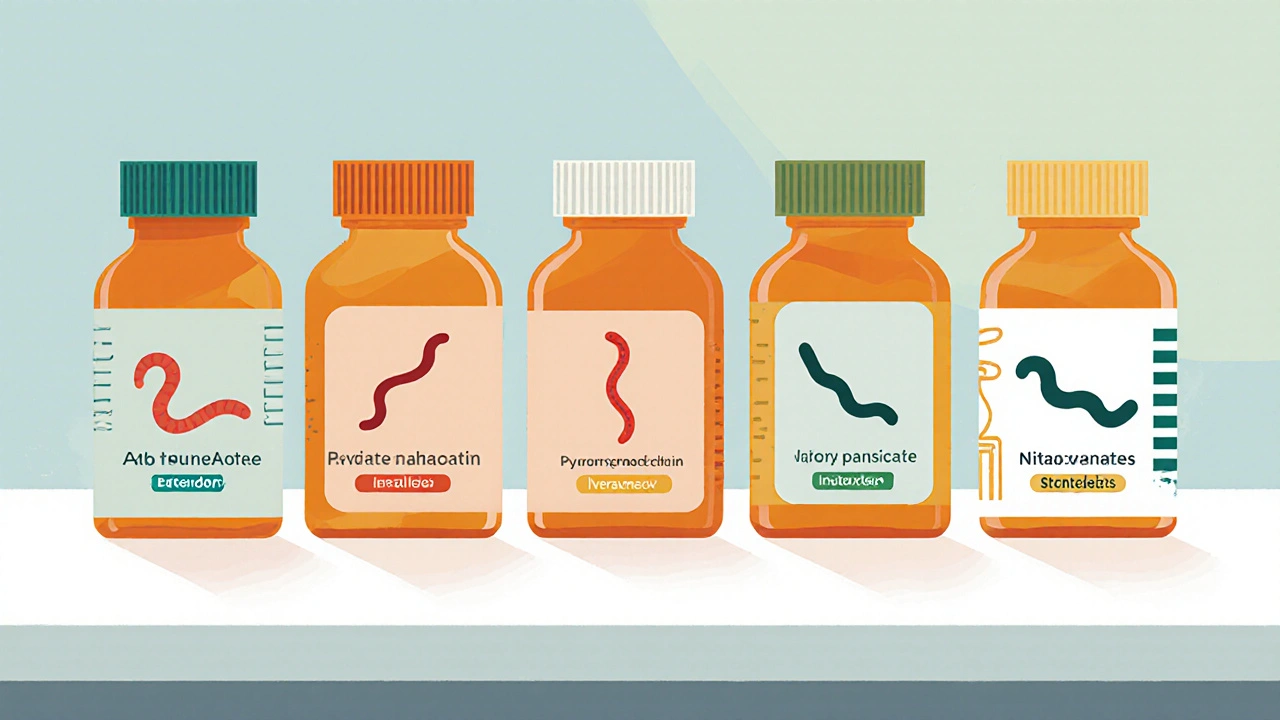Vermox vs Alternatives Comparison Tool
Efficacy Comparison
Recommended Treatment Based on Selection
Select a parasite and treatment type to see recommendations.
Side Effects Overview
- Vermox: Abdominal pain, nausea, headache
- Albendazole: Gastrointestinal upset, dizziness
- Ivermectin: Itching, mild fever, dizziness
- Pyrantel: Transient abdominal cramps, nausea
- Nitazoxanide: Diarrhea, abdominal discomfort
When a loved one shows signs of a worm infection, the first question is often, “Which medicine works best?” Vermox is a household name, but a handful of other drugs promise similar relief. This article breaks down Vermox (Mebendazole) side‑by‑side with its most common alternatives, so you can decide what fits your situation without guessing.
Quick Takeaways
- Vermox (Mebendazole) is a broad‑spectrum benzimidazole that excels against roundworms, hookworms and pinworms.
- Albendazole offers slightly higher tissue penetration, making it better for certain tapeworms.
- Ivermectin shines for strongyloidiasis and onchocerciasis, but has limited activity against common intestinal worms.
- Pyrantel pamoate is a single‑dose over‑the‑counter option, ideal for mild infections.
- Cost, side‑effects and local availability often tip the scale more than raw efficacy.
What is Vermox (Mebendazole)?
Vermox is a prescription antihelminthic whose active ingredient is Mebendazole. It belongs to the benzimidazole class and works by binding to the parasite’s tubulin proteins, halting glucose uptake and ultimately starving the worm.
Typical dosing for children over 2 years and adults is 100mg twice daily for three days, though a single 500mg dose is sometimes used for pinworm treatment. Its safety profile is excellent: most users experience mild abdominal discomfort or transient headache, with serious side‑effects being rare.
How Vermox Works: Mechanism and Spectrum
Mebendazole targets the microtubule assembly of nematodes, disrupting essential cellular processes. Because this mechanism is specific to parasites, human cells are largely unaffected.
The drug’s spectrum includes:
- Roundworms (Ascaris lumbricoides)
- Hookworms (Ancylostoma duodenale, Necator americanus)
- Pinworms (Enterobius vermicularis)
- Some tapeworm species (limited efficacy)
Its limited absorption from the gut means it concentrates where intestinal worms reside, a key advantage for treating heavy infestations.

Popular Alternatives to Vermox
Below are the most frequently prescribed or OTC options that compete with Vermox in the anti‑parasitic market.
Albendazole - Another benzimidazole, administered as 400mg daily for 1‑3 days. It penetrates tissues better than Mebendazole, making it preferred for neurocysticercosis and certain tapeworms.
Ivermectin - A macrocyclic lactone, given as a single 200µg/kg dose for strongyloidiasis and onchocerciasis. While potent against many nematodes, it’s weaker against the common intestinal worms that Vermox targets.
Pyrantel pamoate - Over‑the‑counter 11mg/kg single dose. It causes spastic paralysis of worms, which are then expelled. Best for mild roundworm or pinworm infections, but less effective for heavy hookworm burdens.
Nitazoxanide - A broad‑spectrum thiazolide, 500mg twice daily for 3 days. It works against protozoa and some helminths, offering an alternative when mixed infections are suspected.
Other compounds occasionally mentioned include Mebendazole (the same as Vermox but generic), Benzimidazole class drugs in general, and specific parasite names like Pinworm and Hookworm that influence choice.
Side‑Effect Profile Comparison
| Drug | Common Mild Effects | Rare Serious Effects | Contra‑indications |
|---|---|---|---|
| Vermox (Mebendazole) | Abdominal pain, nausea, headache | Hepatotoxicity (very rare) | Liver disease, pregnancy (first trimester) |
| Albendazole | Gastro‑intestinal upset, dizziness | Bone marrow suppression, liver enzyme elevation | Pregnancy (especially first trimester), severe liver impairment |
| Ivermectin | Itching, mild fever, dizziness | Neurological toxicity in high doses | Loa loa infection, severe liver disease |
| Pyrantel pamoate | Transient abdominal cramps, nausea | Allergic reactions (very rare) | Known hypersensitivity to pyrantel |
| Nitazoxanide | Diarrhea, abdominal discomfort | Liver enzyme abnormalities (rare) | Pregnancy (caution), severe liver disease |
Effectiveness Across Common Parasites
Effectiveness can be visualized as a simple matrix. Scores are based on clinical data from WHO and CDC treatment guidelines (2024 updates).
| Parasite | Vermox | Albendazole | Ivermectin | Pyrantel pamoate | Nitazoxanide |
|---|---|---|---|---|---|
| Roundworm (Ascaris) | 95% | 99% | 85% | 90% | 80% |
| Hookworm | 92% | 94% | 80% | 70% | 75% |
| Pinworm | 98% | 97% | 60% | 95% | 65% |
| Tapeworm (Taenia) | 70% | 90% | 55% | 40% | 85% |
| Strongyloides | 60% | 82% | 95% | 45% | 70% |
Notice that while Vermox scores high for most intestinal worms, Albendazole edges it out for tapeworms and Ivermectin dominates for Strongyloides.

Cost, Availability, and Convenience
- Vermox: Prescription‑only in most countries; generic mebendazole costs $5‑$10 for a three‑day pack.
- Albendazole: Often prescription; generic price similar to Vermox but may require insurance coverage for longer courses.
- Ivermectin: Prescription in the US, OTC in some regions; price varies $10‑$30 per dose.
- Pyrantel pamoate: Widely available OTC; $8‑$12 for a child’s dose.
- Nitazoxanide: Prescription; higher cost $20‑$35 for a three‑day course.
Convenience matters: single‑dose options (pyrantel, ivermectin) win for busy families, while multi‑day regimens (Vermox, Albendazole) may improve compliance for heavy infections.
Choosing the Right Treatment
Follow these practical steps:
- Identify the parasite: A stool test or tape test for pinworms provides the most accurate diagnosis.
- Assess severity: Light infections may respond to OTC pyrantel; heavy loads often need prescription vermox or albendazole.
- Consider patient factors: Pregnancy, liver disease, and age limit certain drugs.
- Check local formulary: Some countries stock albendazole as first‑line for tapeworms.
- Plan follow‑up: Re‑test after treatment to confirm eradication, especially for hookworm and Strongyloides.
In many cases, Vermox offers a balanced mix of efficacy, safety, and cost, but alternatives shine under specific conditions-like ivermectin for Strongyloides or pyrantel for quick, mild infections.
Frequently Asked Questions
Can I use Vermox for a tapeworm infection?
Vermox works on some tapeworms but its cure rate is lower (around 70%). Albendazole or praziquantel are preferred first‑line treatments for most tapeworm species.
Is Pyrantel pamoate as safe as Vermox for children?
Pyrantel is OTC and generally safe for children over 2years. It causes fewer systemic side‑effects because it stays in the gut, but it may be less effective for heavy hookworm infections.
What should I do if I miss a dose of Vermox?
Take the missed dose as soon as you remember, then continue with the regular schedule. If it’s close to the next dose, skip the missed one and resume the plan-don’t double up.
Are there any drug interactions with Vermox?
Mebendazole can increase the blood levels of the anti‑cancer drug cyclophosphamide and may reduce the effectiveness of certain anti‑epileptic drugs. Always discuss current medications with a healthcare provider.
How soon after treatment will symptoms improve?
Most people feel relief within 24‑48hours as the worms die and are expelled. Persistent abdominal pain after a week warrants a follow‑up test.


Mark Mendoza
October 10, 2025
Great overview, folks! 🎉 Vermouth (oops, I mean Vermox) really shines for common roundworms and pinworms, thanks to its gut‑localized action. The side‑effect profile is mild, making it a go‑to for kids and adults alike. If you’re weighing cost, the generic mebendazole packs are usually under $10, which is a win. For heavy hookworm loads, consider pairing with a second dose or switching to albendazole for that extra tissue penetration. Overall, Vermox offers a solid balance of efficacy, safety, and affordability.
Dan Tourangeau
October 18, 2025
Pyrantel is a solid OTC choice for mild pinworm infections.
Bernard Valentinetti
October 25, 2025
Ah, the grand tapestry of anti‑helminthic pharmacology, wherein Vermox occupies but a modest, albeit respectable, niche-indeed, one must appreciate the subtle elegance of benzimidazole chemistry! 🌿 Yet, let us not be beguiled; the marginal 95% cure rate for Ascaris, while commendable, pales in comparison to the 99% offered by its sibling, Albendazole. One might argue that the true merit lies not merely in raw percentages, but in the pharmacokinetic ballet that determines tissue penetration and worm‑specific susceptibility. Thus, when confronting a tapeworm, the discerning clinician would, in good conscience, opt for Albendazole or even Praziquantel, rather than persisting with Vermox's modest 70% efficacy. In sum, while Vermox remains a reliable stalwart for routine intestinal nematodes, the discerning physician should tailor therapy to the parasite’s idiosyncrasies, lest we fall into the trap of one‑size‑fits‑all dogma. 🚀
Lucy Pittendreigh
November 1, 2025
Honestly this article is just a sales pitch for big pharma and you should avoid Vermox altogether it’s overhyped and cheaper alternatives exist.
Nikita Warner
November 9, 2025
From a clinical standpoint, the data presented aligns well with current WHO guidelines. Vermox’s limited absorption is advantageous for intestinal parasites but does restrict its utility against tissue‑migrating helminths. In cases of neurocysticercosis, Albendazole’s superior CNS penetration is decisive. For Strongyloides, the high efficacy of Ivermectin (≈95%) makes it the drug of choice, especially in immunocompromised patients. Cost considerations remain pivotal; generic mebendazole is affordable, yet insurance coverage can affect accessibility. Ultimately, therapeutic decisions should incorporate parasite species, infection severity, patient comorbidities, and local drug availability.
Liam Mahoney
November 16, 2025
Vermox is good but dont forget that albendazole can be more effective for tapeworms, also pyrantel is an option if you want a single dose. Its not alwyas about the best drug but also about whats easy for patient to take.
surender kumar
November 23, 2025
Oh, look at all these fancy percentages-like we’re choosing a wine at a dinner party. 🙄 Sure, Vermox hits 95% for roundworms, but when you have a whole ecosystem of parasites, you need a multi‑tool, not a single‑blade. I mean, why settle for “good enough” when you can have “almost perfect” with Albendazole? And let’s not even start on the convenience factor of a single‑dose pyrantel for those lazy families who can’t remember a three‑day regimen. In short, don’t be dazzled by the numbers; think about real‑world practicality.
JOJO Yang
November 30, 2025
Drama alert: If you don’t take Vermox as prescribed, the worms will throw a party in your intestines! 🐛💥
Faith Leach
December 8, 2025
The pharmaceutical elite don’t want you to know that Vermox is just a placebo engineered by global syndicates to keep us dependent on their endless supply of pills. Wake up!